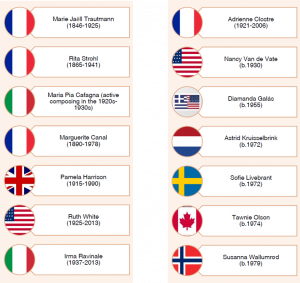In recent blog posts, the Baudelaire Song Project team asked ‘Should feminists should read Baudelaire?’ (1, 2, 3, 4) – a provocative invitation to their readers and guest writers to interrogate their relationship with Baudelaire and his work, considering how this might interact with their relationship to feminism in the wake of #metoo and #balancetonporc.
Another perspective on the place of Baudelaire in relation to feminism can be found through the women who have produced song settings of his poetry. The Baudelaire Song Project database has identified over 80 female composers and performers who have responded to Baudelaire’s poems in song (including the 14 listed below as a small sample of the diversity of composers in the database). For the most part, however, these musicians and their work have been eclipsed in both publishing practices and in critical and scholarly discourse by the canonical settings of male composers such as Debussy, Duparc, and Fauré. Even in the realm of popular musics it has often been the work of male artists such as Léo Ferré that has garnered most public awareness and commercial success.

By focusing our investigative efforts on the lives and work of these female artists, we can try to redress this imbalance in musicological discourse and in wider scholarship of the reception history of Baudelaire’s poetry through song. Studying their work through the lens of feminist theories can also offer some answers to fundamental questions about the concept of song, and provide insight into how meaning is created through collaboration (often distant in time and space) between poet, composer, and performer. My task as undergraduate research scholar with the Baudelaire Song Project this summer has therefore been to bring to light the work of some female musicians, examining along the way how their work can give us specific insight into the workings of song.
This task is not a straightforward one. On a practical level, it is difficult to find information about these women and their work: especially in the case of women composing in the late 19th – early 20th centuries. Even in cases where some information does survive in archival sources, it is often incomplete and inconsistent, and their compositions were often not published and preserved for posterity as readily as those of their male counterparts.
Studying women composers and their work also poses distinct theoretical challenges. What does it mean, for example, to categorise a composer as ‘woman composer’ in the first place? In our efforts to ‘redress the balance’, are we in fact doing these composers and the feminist cause a disservice by giving in to essentialising tendencies? In the wake of #metoo, debate has surfaced surrounding the practice of separating the artist and their work, and whether this should be the case of male artists accused of sexual harassment and assault, such as Woody Allen for example. This might lead us to ask how this debate would play out in another context: to what degree should we separate women composers and their work? Should their work be read in the context of their gender or does this only contribute further to its segregation from and subjugation to the predominantly male-authored canon?
I have certainly not found answers to all of these questions during my five-week UGRS placement with the Baudelaire Song Project. My research contributes however to mitigating the practical difficulties in finding information on female composers and their settings of Baudelaire poems, by working to complete some of the entries in the Baudelaire Song Project database using online and physical archival resources. I have also sought to promote awareness of the diversity of female composers in the Baudelaire Song Project database by means of two blog posts for the Baudelaire Song Project website, and a research poster to be presented at the UGRS showcase at the University of Birmingham in October 2018.
In response to some of the theoretical questions outlined above, I have also undertaken more in-depth research into one of the composers identified by the Baudelaire Song Project database, Diamanda Galás. I write more about my research into her setting of ‘Litanies de Satan’ in my second blog post on the Baudelaire Song Project website (coming soon!).
Emelia Lavender, BMus Music
